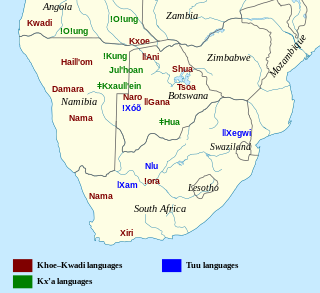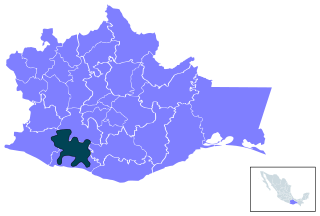Related Research Articles
In phonetics, aspiration is the strong burst of breath that accompanies either the release or, in the case of preaspiration, the closure of some obstruents. In English, aspirated consonants are allophones in complementary distribution with their unaspirated counterparts, but in some other languages, notably most South Asian languages and East Asian languages, the difference is contrastive.

The International Phonetic Alphabet (IPA) is an alphabetic system of phonetic notation based primarily on the Latin script. It was devised by the International Phonetic Association in the late 19th century as a standardized representation of speech sounds in written form. The IPA is used by lexicographers, foreign language students and teachers, linguists, speech–language pathologists, singers, actors, constructed language creators, and translators.
Rotokas is a North Bougainville language spoken by about 4,320 people on the island of Bougainville, an island located to the east of New Guinea, which is part of Papua New Guinea. According to Allen and Hurd (1963), there are three identified dialects: Central Rotokas, Aita Rotokas, and Pipipaia; with a further dialect spoken in Atsilima (Atsinima) village with an unclear status. Central Rotokas is most notable for its extremely small phonemic inventory and for having perhaps the smallest modern alphabet.

TaaTAH, also known as ǃXóõKOH, is a Tuu language notable for its large number of phonemes, perhaps the largest in the world. It is also notable for having perhaps the heaviest functional load of click consonants, with one count finding that 82% of basic vocabulary items started with a click. Most speakers live in Botswana, but a few hundred live in Namibia. The people call themselves ǃXoon or ʼNǀohan, depending on the dialect they speak. The Tuu languages are one of the three traditional language families that make up the Khoisan languages. In 2011, there were around 2,500 speakers of Taa.
Hopi is a Uto-Aztecan language spoken by the Hopi people of northeastern Arizona, United States.
In phonetics, nasalization is the production of a sound while the velum is lowered, so that some air escapes through the nose during the production of the sound by the mouth. Examples of archetypal nasal sounds include and.

Hadza is a language isolate spoken along the shores of Lake Eyasi in Tanzania by around 1,000 Hadza people, who include in their number the last full-time hunter-gatherers in Africa. It is one of only three languages in East Africa with click consonants. Despite the small number of speakers, language use is vigorous, with most children learning it, but UNESCO categorizes the language as vulnerable.

The Muscogee language, previously referred to by its exonym, Creek, is a Muskogean language spoken by Muscogee (Creek) and Seminole people, primarily in the US states of Oklahoma and Florida. Along with Mikasuki, when it is spoken by the Seminole, it is known as Seminole.
The Sikkimese language, also called Sikkimese, Bhutia, or Drenjongké, Dranjoke, Denjongka, Denzongpeke and Denzongke, belongs to the Tibeto-Burman languages. It is spoken by the Bhutia in Sikkim, India and in parts of Koshi, Nepal. It is the Official Language of Sikkim, India. The Sikkimese people refer to their own language as Drendzongké and their homeland as Drendzong. Up until 1975 Sikkimese was not a written language. After gaining Indian Statehood the language was introduced as a school subject in Sikkim and the written language was developed.

Chatino is a group of indigenous Mesoamerican languages. These languages are a branch of the Zapotecan family within the Oto-Manguean language family. They are natively spoken by 45,000 Chatino people, whose communities are located in the southern portion of the Mexican state of Oaxaca.
Unlike many languages, Icelandic has only very minor dialectal differences in sounds. The language has both monophthongs and diphthongs, and many consonants can be voiced or unvoiced.
The most thorough treatment of the Kiowa sound system is by Laurel Watkins in a generative framework. A consideration of prosodic phenomena with acoustic analysis is in Sivertsen (1956). Earlier discussions of phonemics are Trager (1960), Merrifield (1959), Wonderly et al. (1954), and Harrington (1928).
Izi is an Igboid language spoken in Ebonyi state in Nigeria. It forms a dialect cluster with the closely related languages Ikwo, Ezza, and Mgbo.
Afitti is a language spoken on the eastern side of Jebel el-Dair, a solitary rock formation in the North Kordofan province of Sudan. Although the term ‘Dinik’ can be used to designate the language regardless of cultural affiliation, people in the villages of the region readily recognize the terms ‘Ditti’ and ‘Afitti.’ There are approximately 4,000 speakers of the Afitti language and its closest linguistic neighbor is the Nyimang language, spoken west of Jebel el-Dair in the Nuba Mountains of the South Kordofan province of Sudan.
Gwari is a Nupoid language spoken by the Gbagyi people, which make up over a million people in Nigeria. There are two principal varieties, Gbari and Gbagyi, which have some difficulty in communication; sociolinguistically they are distinct languages.
Irarutu, Irahutu, or Kasira, is an Austronesian language of most of the interior of the Bomberai Peninsula of north-western New Guinea in Teluk Bintuni Regency. The name Irarutu comes from the language itself, where ira conjoins with ru to create 'their voice'. When put together with tu, which on its own means 'true', the meaning of the name becomes 'Their true voice' or 'The people's true language'.

Ute is a dialect of the Colorado River Numic language, spoken by the Ute people. Speakers primarily live on three reservations: Uintah-Ouray in northeastern Utah, Southern Ute in southwestern Colorado, and Ute Mountain in southwestern Colorado and southeastern Utah. Ute is part of the Numic branch of the Uto-Aztecan language family. Other dialects in this dialect chain are Chemehuevi and Southern Paiute. As of 2010, there were 1,640 speakers combined of all three dialects Colorado River Numic. Ute's parent language, Colorado River Numic, is classified as a threatened language, although there are tribally-sponsored language revitalization programs for the dialect.
Zacatepec Chatino is an indigenous Mesoamerican language, one of the Chatino family of the Oto-Manguean languages. It is often referred to as ChaqF tinyaJ KichenA tziC, Chatino de San Marcos Zacatepec, or Chatino de Zacatepec as it is distinct from other Chatino languages in the region. Zacatepec Chatino is part of the Eastern Chatino languages. It is spoken in the town of San Marcos Zacatepec, a town of approximately 1,000 people and inhabited by an indigenous group known as the Chatino people. The language was once spoken in the village of Juquila, but is now virtually extinct with two surviving speakers in the area.

Kagate or Syuba is a language from the subgroup of Tibetic languages spoken by the Kagate people primarily in the Ramechhap district of Nepal.
References
- ↑ Western Highland at Ethnologue (19th ed., 2016)

Eastern Highland (Lachao-Yolotepec) at Ethnologue (19th ed., 2016)
Nopala at Ethnologue (19th ed., 2016)
- ↑ Unicode submission L2/20-251
- ↑
- Rasch, Jeffrey Walker. 2002. The basic morpho-syntax of Yaitepec Chatino. Ph.D. thesis. Rice University.